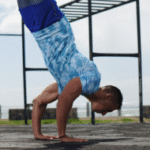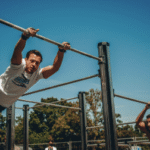How Private Calisthenics Training Differs for Men vs. Women
In calisthenics, the goal is to master your own bodyweight. While this mission is universal, a one-on-one coach’s approach will differ for men and women because of key physiological distinctions and common training objectives. A great coach doesn’t use a one-size-fits-all template; they create a personalized blueprint that respects these differences to maximize results and prevent injury.
Foundational Physiological Differences
The primary differences in how men and women adapt to strength training are rooted in physiology and biomechanics.
Upper Body Strength and Muscle Mass: Men generally have a higher baseline of upper body strength. Due to hormonal differences, particularly higher levels of testosterone, they tend to build muscle mass, especially in the upper body, more readily.
Implication for Men: A coach might find that a male client can progress more quickly through initial pushing and pulling exercises like dips and pull-ups. The program may introduce weighted variations or more complex skills sooner to ensure continuous challenge.
Implication for Women: A coach will typically design a more gradual and systematic progression for upper body movements. The initial focus will be on building a strong foundation with exercises like incline push-ups , Australian rows , and negative pull-ups . This patient approach is crucial for developing tendon and ligament strength in the elbows and shoulders, preventing injury and building the necessary base for more advanced skills.
Lower Body Strength and Mobility: Women often have a biomechanical advantage in lower body movements. A typically lower center of gravity and greater hip mobility can make exercises like deep squats and pistol squats feel more natural.
Implication for Women: A female client might excel at lower body skills more quickly. A coach can leverage this by introducing single-leg variations or more complex squat patterns earlier in the training.
Implication for Men: Men often have tighter hips and hamstrings. A coach will frequently need to program more dedicated mobility and flexibility work to help a male client achieve proper squat depth and prevent lower back compensation.
Hormonal Cycles and Recovery: The male hormonal profile is relatively stable, while the female menstrual cycle creates fluctuations in energy, strength, and recovery throughout the month.
Implication for Men: Programming can often be more linear without accounting for hormonal shifts.
Implication for Women: A knowledgeable coach will adapt the training intensity based on the client’s cycle. They may program higher-intensity, strength-focused sessions during the follicular phase (when energy is typically higher) and focus more on technique, mobility, or lower-intensity volume during the luteal phase or during menstruation. This intelligent programming prevents burnout and optimizes performance.
Common Goals and Program Design
While goals are always individual, certain trends often emerge that influence how a coach structures a program.
Common Goals for Women: Many women seek private coaching to achieve a “toned” physique (building lean muscle and reducing body fat), with a particular focus on developing strong glutes and legs. They often view achieving a skill like a pull-up or a handstand as a significant benchmark of strength and empowerment.
A Coach’s Approach for Women: The program will likely feature a higher volume of lower-body compound movements. For the upper body, the coach will create a structured, encouraging path toward that first pull-up, breaking it down into achievable milestones to build both strength and confidence. The focus is on building a balanced, athletic, and capable physique.
Common Goals for Men: Men often come to calisthenics with the goal of building a “V-taper” physique (broad shoulders, strong back, narrow waist) and mastering impressive “power” skills like the muscle-up or the planche .
A Coach’s Approach for Men: The program will heavily emphasize vertical pulling (weighted pull-ups), dipping variations, and the specific straight-arm conditioning necessary for skills like the planche. The coach will focus on building the raw strength and tendon resilience required for these high-intensity movements.
The Unifying Principles
Despite these differences, the core principles of excellent coaching remain the same for everyone, regardless of gender:
Personalized Assessment: Every program, for every client, must begin with a thorough assessment of their individual movement patterns, strengths, and weaknesses.
Progressive Overload: To get stronger, the body must be consistently challenged. This principle is universal.
Perfect Form: Safety and efficiency are always the top priorities.
Consistency: The best program is the one you can stick with. A coach helps build a routine that fits your life in Houston, whether you’re a busy professional or a student at UH.
Conclusion
Private calisthenics training is not a gender-neutral service; it is a deeply personal one. A skilled coach understands that while the destination—mastery of one’s own body—may be the same, the maps to get there are different. By honoring the unique physiological and goal-oriented differences between men and women, a coach can design a path that is not only faster and safer but also more empowering and enjoyable for every individual.

How Private Calisthenics Training Differs for Men vs. Women
Route
Calisthenics Gym Houston Functional Bodyweight Training
Secondary phone: (346) 483-3195
Email: info@calisthenicsclubhouston.com
URL: https://calisthenicsclubhouston.com/
Monday 6:00 AM - 7:00 PM Tuesday 6:00 AM - 7:00 PM Wednesday 6:00 AM - 7:00 PM Thursday 6:00 AM - 7:00 PM Open now Friday 12:00 PM - 6:30 PM Saturday 9:45 AM - 12:00 PM Sunday 3:00 PM - 5:00 PM





